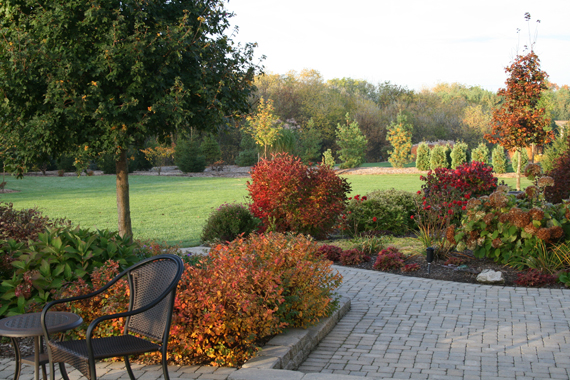Moving into our new home in 2004 I was filled with great excitement at having over 2 acres to garden. Building our gardens over the past few years, I have been at times excited, at times challenged and more often than I like to admit, overwhelmed.
For the first time this year, I finally had a sense that I was nearing my objective of creating a cohesive and flowing landscape.
In landscaping our yard, I tried to follow a few key concepts.
1. Work in small vignettes
Not being a landscaper by trade or by nature, I found trying to design a landscape for our entire property much to daunting a task. So instead, I worked area by area, creating a look and feel that I felt fit that particular spot… a bird garden, a woodland, a native garden, a vegetable garden, a small grove, all designed to fit in with their particular location and needs. Yet each was also designed to tie into their surrounding landscape.
2. Make use of what is already there
Although it is tempting to start with a blank slate, if at all possible make use of what nature has provided. A natural grove of hawthorn trees in the scrub brush behind our yard provide a spectacular site in bloom in spring. By clearing the underlying brush, limbing up many of the trees, adding some paths and a seating area, another view was born with little material required.
3. Use a variety of materials
It is a fact today that there are many invasive bugs and diseases that are harming many shrub and tree species. To avoid having large areas harmed by bugs or disease, I used a wide variety of trees and shrubs in our landscape. Avoiding a few problem species, no matter how pleasant their descriptions in the garden catalogue, does not mean you will have a boring landscape.
4. Add native species to the landscape
As I expanded my plant repertoire, I became more aware of the beauty and benefits of adding native species to my garden. Although I do not plan to limit myself to just native plant material, there are benefits to increasing the number of native varieties in a garden. The wide variety and unique nature of many of the native species makes for a more interesting garden.
5. Connect the vignettes
Having designed our entire yard piece by piece, the main challenge was to make sure everything flowed and appeared as a cohesive landscape. Repetition of key elements, pathways and seating areas between different vignettes helped transition one section to another. Pathways through and between major areas also help give the appearance of a thoughtful overall design plan.
6. Vary plant heights
With such a large area I wanted to be able to look through one garden and see other gardens as a backdrop. Rather than following the tradition of smaller plants in the front and larger in the back, vary your plant heights throughout you beds creating small view windows through which you can see other vignettes you have created.
7. Plant what pleases you
Lastly, and I think most importantly, design and plant for what pleases you. I am a confirmed tree and shrub addict and not at all a fan of most perennials. Although they can add colour, I find the colour explosion mostly short-lived and the amount of work not worth the return for me. My selection of perennials is limited to those that look nice all season and require low care.But that’s me. You on the other hand might like the cottage garden look. Whatever your style, follow it no matter what the garden books say!
